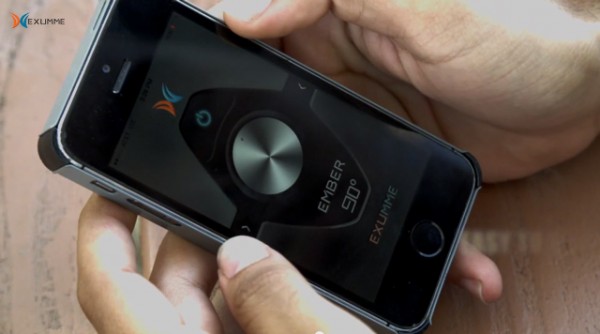iPhone's Embercase Functions as a Hand Warmer
| Marc Maligalig | | Oct 29, 2014 06:32 AM EDT |
(Photo : Facebook)
Exumme, a tech company from Palo Alto, California, has developed the Embercase, an iPhone case that protects the phone and warms a user's hands.
The device, which is currently looking for backers in fundraising site Kickstarter, is made from titanium and has a battery-powered heating element at the back that provides warmth.
Like Us on Facebook
The case has a built-in layer of Aerogel ceramic fiber to protect the phone from the heat it generates. The case also has polycarbonate corners that protect the handset from drops and bumps.
The iPhone connects to the Embercase via a Bluetooth connection that regulates the phone's temperature using the Embercase's app.
The Embercase is set to retail for US$90 and will be available on the iPhone 6, iPhone 5 and iPhone 5S.
While the case is intentionally designed to provide a pleasant warmth, unwarranted heating of a mobile device is something consumers should be on the lookout for.
The sudden heating of a device usually comes with a quick draining of the device's battery. The heating almost always signal a short circuit in the mobile device's cells
To address the problem, a team of scientists from Stanford University developed a system that tells users when their lithium ion batteries are overheating or are a few degrees away from burning a hole in their pockets.
"Our goal is to create an early-warning system that saves lives and property," said Yi Cui, associate professor of materials science and engineering at Stanford.
A lithium ion battery consists of two electrodes, a lithium metal-oxide cathode and a carbon anode, packed tightly side-by-side. The two electrodes are separated by a thin layer of polymer. Batteries that have a damaged polymer film let its two electrodes meet, possibly leading to overheating, short-circuiting or an explosion.
The layer of polymer, which is made from the same material in plastic bottles, is also porous enough to let lithium ions flow between the electrons through a flammable electrolyte solution. The polymer is designed to behave this way, but any problems during its manufacturing stage could be potentially dangerous.
The system developed by Cui and his team involves adding a thin layer of copper on one side of the plastic separator, making an extra layer that is described by the team as the third electrode.
"The copper layer acts like a sensor that allows you to measure the voltage difference between the anode and the separator," said co-lead author and graduate student Denys Zhuo.
The company, which is aiming to raise at least US$50,000 on the fund-raising website, has already earned more than US$9,000. It still has 25 days left before the project is taken down on Kickstarter.
TagsExumme, Embercase, Hand warmer, iphone 5, iPhone 5S
©2015 Chinatopix All rights reserved. Do not reproduce without permission
EDITOR'S PICKS
-

Did the Trump administration just announce plans for a trade war with ‘hostile’ China and Russia?
-

US Senate passes Taiwan travel bill slammed by China
-

As Yan Sihong’s family grieves, here are other Chinese students who went missing abroad. Some have never been found
-

Beijing blasts Western critics who ‘smear China’ with the term sharp power
-

China Envoy Seeks to Defuse Tensions With U.S. as a Trade War Brews
-

Singapore's Deputy PM Provides Bitcoin Vote of Confidence Amid China's Blanket Bans
-

China warns investors over risks in overseas virtual currency trading
-

Chinese government most trustworthy: survey
-

Kashima Antlers On Course For Back-To-Back Titles
MOST POPULAR
LATEST NEWS
Zhou Yongkang: China's Former Security Chief Sentenced to Life in Prison

China's former Chief of the Ministry of Public Security, Zhou Yongkang, has been given a life sentence after he was found guilty of abusing his office, bribery and deliberately ... Full Article
TRENDING STORY

China Pork Prices Expected to Stabilize As The Supplies Recover

Elephone P9000 Smartphone is now on Sale on Amazon India

There's a Big Chance Cliffhangers Won't Still Be Resolved When Grey's Anatomy Season 13 Returns

Supreme Court Ruled on Samsung vs Apple Dispute for Patent Infringement

Microsoft Surface Pro 5 Rumors and Release Date: What is the Latest?










